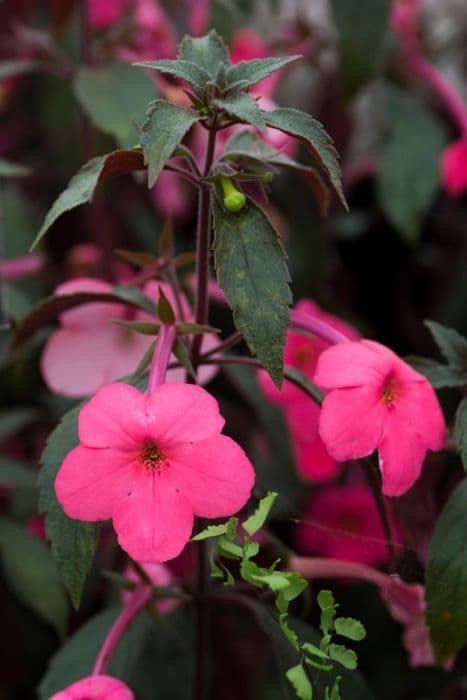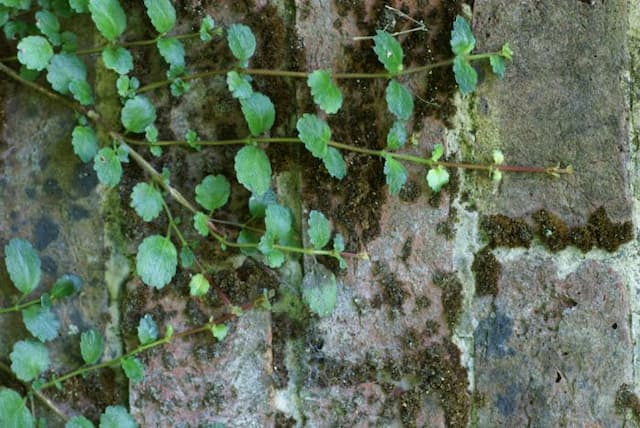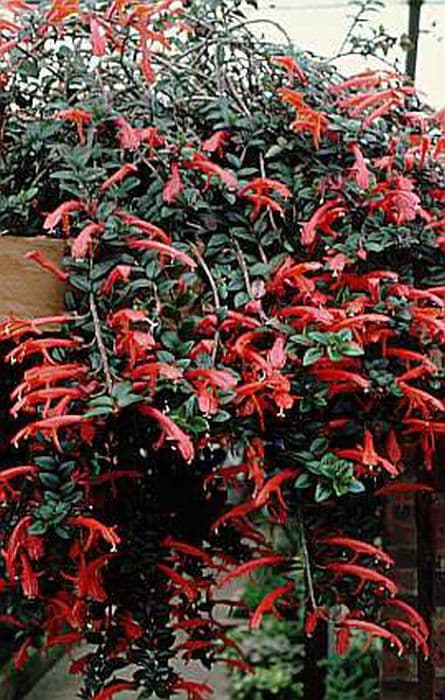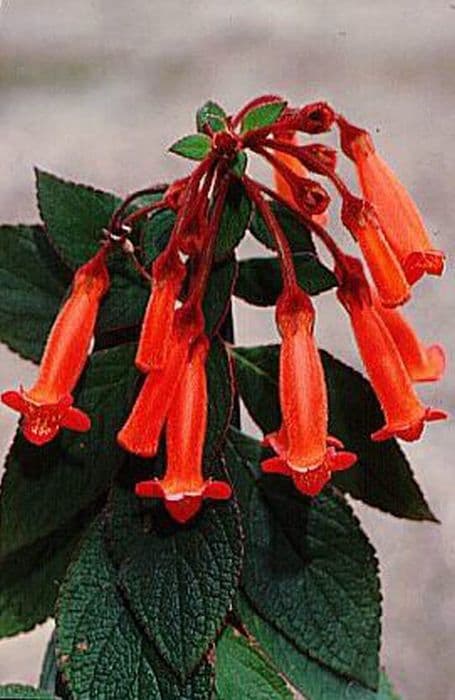Little Grebe Petrocosmea minor

ABOUT
Petrocosmea minor, commonly referred to as none, is a charming herbaceous perennial that is part of the African violet family. This plant typically features a compact rosette of rounded, fleshy leaves that are a lush green in color. The leaves are somewhat small and may have a slightly quilted surface, providing a soft, somewhat velvety texture. They can appear slightly scalloped at the edges, enhancing the detailed appearance of the foliage. When in bloom, the flowers emerge on delicate stems that rise subtly above the foliage. The blooms are quite attractive, sporting a funnel shape with a flared mouth and exhibiting a pleasing symmetry. They usually manifest in gentle shades of blue or lavender and occasionally may have a throat with contrasting colors such as white or yellow, creating a striking visual effect. The plant's overall form is neat and clump-forming, with its foliage and flowers creating an elegant and decorative presentation that is often favored by enthusiasts for its understated yet refined beauty. It prefers a humid environment and does not tolerate direct sun very well, thriving best in filtered light conditions, making it an excellent choice for a terrarium or a shaded windowsill garden.
About this plant
 Names
NamesFamily
Gesneriaceae
Synonyms
There are no widely recognized common names for Petrocosmea minor; it is typically referred to by its scientific name.
Common names
Petrocosmea minor.
 Toxicity
ToxicityTo humans
As of my last update, there is no well-documented evidence to suggest that Petrocosmea minor, commonly known as Petrocosmea, is toxic to humans. There are no commonly reported symptoms of poisoning from ingestion of this plant. However, it is always advisable to exercise caution and avoid ingesting plants not known to be safe for consumption, as individual reactions can vary.
To pets
Petrocosmea minor, commonly referred to as Petrocosmea, is not commonly known to be toxic to pets. There is limited information available regarding its toxicity in animals, and it does not appear on most lists of poisonous plants for pets. Nevertheless, it is always prudent to prevent pets from ingesting plants, as even non-toxic plants can sometimes cause gastrointestinal upset or other issues in animals if consumed.
 Characteristics
CharacteristicsLife cycle
Perennials
Foliage type
Evergreen
Color of leaves
Green
Flower color
Blue
Height
0 feet 6 inches (15 cm)
Spread
0 feet 6 inches (15 cm)
Plant type
Herb
Hardiness zones
10
Native area
China
Benefits
 General Benefits
General Benefits- Aesthetic Appeal: Petrocosmea minor, commonly known as Dwarf Petrocosmea, adds visual interest to indoor and outdoor spaces with its rosette of lush green leaves and delicate blue or violet flowers.
- Low Maintenance: Dwarf Petrocosmea is relatively easy to care for, making it suitable for beginner gardeners or those who prefer plants that don't require constant attention.
- Compact Size: Its small size makes it an ideal choice for terrariums, small pots, or as part of a miniature garden display.
- Habitat Enrichment: In its native habitat, it can provide shelter and food for small insects, contributing to biodiversity.
- Psychological Benefits: Like other houseplants, the presence of Dwarf Petrocosmea can contribute to reduced stress levels and enhanced mood for individuals who enjoy indoor gardening.
- Educational Value: Cultivating Petrocosmea minor can offer educational opportunities for children and adults to learn about plant care, botany, and the diversity of plant species.
 Medical Properties
Medical PropertiesThis plant is not used for medical purposes.
 Air-purifying Qualities
Air-purifying QualitiesThis plant is not specifically known for air purifying qualities.
 Other Uses
Other Uses- Artistic Inspiration: Petrocosmea minor, with its unique foliage and delicate blossoms, can serve as a muse for visual artists, inspiring botanical illustrations and nature-themed artwork.
- Educational Tool: This plant can be used in biology classrooms to teach students about plant anatomy, growth patterns, and the life cycle of flowering plants.
- Photography Subject: The intricate details and vibrant colors of Petrocosmea minor make it a desirable subject for macro photography and horticultural photography aficionados.
- Landscape Design: Due to its compact size and ornamental value, Petrocosmea minor can be used to enhance rock gardens or terrarium landscapes.
- Jewelry Design: Real or sculpted representations of Petrocosmea minor flowers can be incorporated into unique, nature-inspired jewelry pieces.
- Stamp Collecting: The striking appearance of Petrocosmea minor has potential to be featured on postal stamps, appealing to philatelists with a fondness for botanical themes.
- Miniature Settings: The small scale of Petrocosmea minor suits it perfectly for detailed fairy gardens and miniature scenes created by hobbyists.
- Cooking Garnish: Although not commonly consumed, the blossoms could theoretically be used as a non-toxic, decorative garnish for culinary presentations.
- Traditions and Celebrations: In some cultures, unique plants like Petrocosmea minor could play a role in festivals or ceremonies as symbols of nature’s beauty.
- Crafting Material: The leaves and flowers, once dried, could be used in crafting activities, such as making bookmarks, pressed-flower cards or potpourri.
Interesting Facts
 Feng Shui
Feng ShuiThe plant Petrocosmea minor is not used in Feng Shui practice.
 Zodiac Sign Compitability
Zodiac Sign CompitabilityThe plant Petrocosmea minor is not used in astrology practice.
 Plant Symbolism
Plant Symbolism- Delicacy: Petrocosmea minor, often known as the 'Small Petrocosmea,' features small, delicate leaves and flowers that suggest sensitivity and careful handling.
- Harmony: The symmetrical growth pattern of the Small Petrocosmea often stands for balance and harmony in one's life.
- Purity: The pristine, often blue to violet flowers of the plant may symbolize cleanliness, innocence, and purity of intent.
- Hidden Beauty: The Small Petrocosmea isn't a widely-known plant, which could represent undiscovered or understated beauty.
- Perseverance in Adversity: Despite its delicate appearance, the Small Petrocosmea is quite resilient, symbolizing the ability to overcome challenges.
 Water
WaterThe Petrocosmea minor, commonly known as Miniature Petrocosmea, prefers consistent moisture without becoming waterlogged. Water this plant when the top inch of soil feels dry, typically once a week, using approximately 4 ounces of water each time. It's important to avoid letting water sit in the saucer beneath the pot as this can lead to root rot. During the active growing season in spring and summer, Miniature Petrocosmea may require more frequent watering. In contrast, during the dormant winter months, reduce watering to every other week to prevent oversaturation.
 Light
LightThe Miniature Petrocosmea thrives in bright, indirect light but can tolerate medium light conditions. Direct sunlight should be avoided as it can scorch the leaves. An east or north-facing window is ideal, offering the plant bright light without the harshness of direct afternoon sun.
 Temperature
TemperatureMiniature Petrocosmea prefers temperatures between 60°F and 75°F. It can tolerate a minimum temperature of around 50°F but will suffer if exposed to temperatures below that. The plant does not handle extreme heat well, so it's best to avoid locations where temperatures exceed 80°F.
 Pruning
PruningPrune the Miniature Petrocosmea to maintain its shape and encourage bushier growth. It is best to prune in the spring before the onset of new growth. Occasional pruning may be necessary to remove any dead or yellowing leaves, which can be done as needed throughout the year.
 Cleaning
CleaningAs needed
 Soil
SoilPetrocosmea minor, commonly called Minor Petrocosmea, thrives in well-draining soil with a mix of potting soil, perlite, and fine bark. The soil pH should be slightly acidic to neutral, around 6.0 to 7.0, which suits its growth needs.
 Repotting
RepottingMinor Petrocosmea should be repotted every 1-2 years, or when it becomes root-bound. Choose a slightly larger pot to give the roots more room to grow.
 Humidity & Misting
Humidity & MistingMinor Petrocosmea prefers high humidity levels, ideally between 60% and 80%. Maintaining this level of humidity will support its lush foliage and overall health.
 Suitable locations
Suitable locationsIndoor
Place it in bright, indirect light away from drafts.
Outdoor
Keep in partial shade; protect from strong winds.
Hardiness zone
10-11 USDA
 Life cycle
Life cycleFor Petrocosmea minor, commonly known as Dwarf Petrocosmea, the life cycle begins with seed germination, typically in a moist, well-draining growing medium under partial shade to avoid direct sunlight, which may take several weeks. After germination, the seedling stage follows, where the first true leaves develop and the plant starts to form its characteristic compact rosette. During the vegetative stage, the Dwarf Petrocosmea grows and matures, developing more leaves in a rosette pattern, and it requires consistent moisture and occasional feeding with a balanced fertilizer. The flowering stage occurs when the plant produces small, but attractive flowers, usually blue to purple in color, which can happen multiple times a year if growing conditions are favorable. After pollination, if successful, the flowers may produce seeds, completing the reproductive cycle. The plant can also propagate vegetatively via leaf cuttings or division, allowing for the continuation of the life cycle beyond the lifespan of an individual plant.
 Propogation
PropogationPropogation time
Spring to Summer
Petrocosmea minor, commonly known as a type of Fairy Bells, can be propagated most effectively through leaf cuttings. The ideal time for propagation is during the spring or early summer when the plant is in its active growth phase. To propagate using leaf cuttings, select a healthy, mature leaf and cut it with a sharp, sterilized knife or scissors, including about an inch of the petiole. Dip the petiole end of the leaf cutting into rooting hormone powder to encourage root growth, and then insert the cutting into a moist potting mix composed of peat and perlite in equal parts. Cover the pot with a plastic bag or place it in a humidity dome to maintain high humidity and avoid letting the leaves dry out. Roots will typically develop within a few weeks, after which you can gradually acclimate the new plant to less humid conditions by opening the plastic bag or removing the dome for an increasing number of hours each day. Once the plant is stable, you can transplant it to a standard potting mix and continue to care for it as you would a mature Petrocosmea minor.









